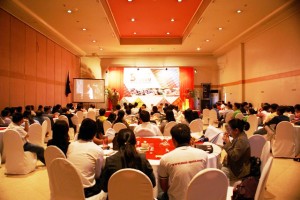MICOOP builds a better world

One-hundred thirty-two delegates gather at the 5th Annual National MICOOP Forum held at the Pryce Plaza Hotel, in Cagayan de Oro City, on April 19-21. MICOOP is Microfinance Innovations in Cooperatives, the Countryside Microfinance thrust of the National Confederation of Cooperatives. MICOOP has improved the lives of more 93,000 – providing loans and enabling thrift and savings. Photo by ANGEL P. GARCIA, JR.
CAGAYAN DE ORO CITY – They came from as far north as Ilocos Norte and as far south as Sarangani Province. One-hundred thirty-two branch managers and staff, and cooperative leaders from the 50 branches of the Microfinance Innovations in Cooperatives Program (MICOOP) of the National Confederation of Cooperatives (NATCCO Network) converged at the Pryce Plaza Hotel on Thursday April 19 to 21, 2012 for the 5th Annual National MICOOP Forum.
Their battlecry is the United Nations theme in the International Year of Cooperatives 2012, that “Cooperative Enterprises Build a Better World.”
Under the MICOOP Program, the NATCCO Network partners with cooperatives to put up branches in “areas with high poverty incidence, where even banks are generally reluctant to establish a branch.”
Arrangements can either be Build-Operate-Transfer, where the NATCCO’s investment and the partner co-op is negotiable, with the co-op having the option to buy-out the NATCCO. In some cases, the branch opts to buy itself out and registers itself as an independent cooperative.
The MICOOP Program began in 2006, and has opened 78 branches since. At the moment, 28 branches have been bought out so the MICOOP still handles only 50. Some branches manage to break even in less than two years.
Each branch provides financial services to its members, usually from the local community. Members are encouraged to save and open an account, may avail of loans, and are educated on financial literacy, or how to handle money.
“NATCCO seeks to lend to the ‘enterprising poor’ who want to put up small businesses but have no access to formal lending institutions and/or are dependent on usurers who charge high loan rates,” said Evelia B. Tizon, MICOOP Group Head.
We are proving that co-ops can be innovative and viable. MICOOP proves that the poor can be reliable , they can save and pay their loans. They can be trusted,” she added.
To erase the negative image surrounding co-ops, the MICOOP has adopted ‘bank-like operations’ like professionalizing staff, paying them appropriate salaries, using computers, building excellent offices, drafting standardized operation manuals, having a vault and security guards in all its branches, and many more.
Gone are the days when co-ops were backyard operations: “Some don’t want to hire security guards because it’s expensive? Then put a dog that can bark loud!” she said.
NATCCO, which commits up to P10 million in some branches, has invested P418 million. The program has so far reached 93,723 individual members, in 30 provinces all over the archipelago. P978 million have been loaned out since 2006, which Tizon boasts, was used by borrowers to put up small enterprises. And many of these entrepreneurs are no longer borrowers, but have become depositors.
But the biggest boast is that internal funds have been generated – without borrowing from outside sources. Share Capital and Deposits nationwide total P254 million. And combined branch assets stand at P659 million.
The MICOOP employs 446 people in the localities, making it a champion of countryside employment.
Program partners include the Cooperative Development Authority (CDA), Department of Agrarian Reform (DAR), and the Land Bank of the Philippines. Foreign funders include Bank IM Bistum (Germany), Inter Church Development Cooperation or ICCO (Netherlands) and Cordaid (Netherlands). The first two branches were established with PLAN International.
First keynote speaker was CDA Executive Director, Orlando R. Ravanera pledged support: “I will tell all CDA Regional Directors, if “Micoop” is mentioned . . . expedite!” This was met with applause.
DAR Undersecretary Jerry E. Pacturan, likewise, recognized the MICOOP’s importance: “Many of DAR’s activities have been easier to implement because of MICOOP’s financial services to farmers!”
Mr. Augusto D. Camba, of ICCO, said: “ICCO can’t make an impact if we work alone.” He also lauded MICOOP’s support for Agrarian Reform Cooperatives as a key component in market chain development in agriculture.
